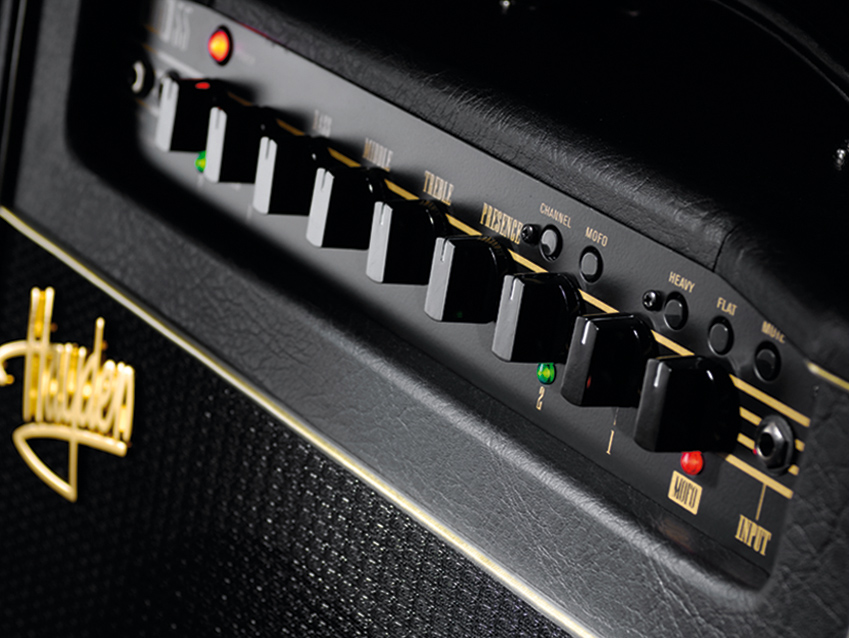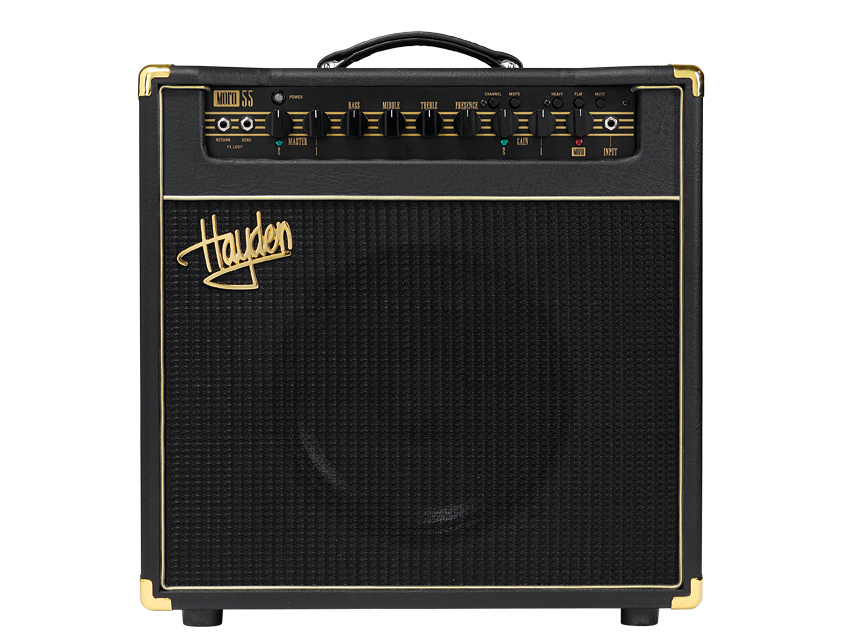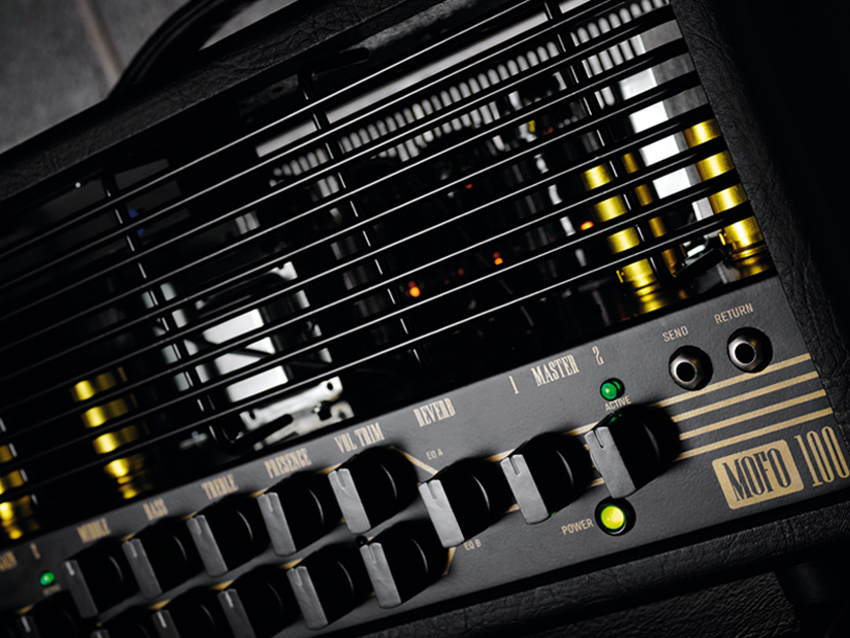MusicRadar Verdict
A credible rock-orientated 1 x 12 combo capable of a wide range of sounds with enough volume for small and medium gigs.
Pros
- +
Wide range of tones. Sensible physical size. Plenty loud.
Cons
- -
Not everybody likes sizzly overdrive. EQ pots extremely sensitive.
MusicRadar's got your back

Hayden Mofo 55 combo

Hayden Mofo 55 combo

Hayden Mofo 55 combo
Over two years have passed since we first saw a Hayden MoFo at Winter NAMM 2009. A new concept for the British brand, the idea was simple: a highly portable head, but with enough volume and tonal flexibility for practise and small gigs.
Thirty watts was enough for many players, but inevitably there are noisier, rockier Herberts who like the idea, but need more grunt. For 2011 then, welcome the MoFo 55 and 100, the first of which we have here…
"As you'd hope for British-made amps, the standard of the birch ply cabinetry is well up to snuff."
The 55 is one of two combos in the range, along with a smaller 15-watter. It's also available as a head, where familial hallmarks include the black 'n' gold livery and the cage-like bars - maybe these bad MoFos want to break out! The combo looks a little more restrained by comparison.
As you'd hope for British-made amps, the standard of the birch ply cabinetry is well up to snuff, as is the general fit and finish of the black, leather-like vinyl, smart gold-coloured corners, front-panel printing and all that surprisingly difficult stuff all too easily taken for granted.
Size and shape-wise, it's square from the front, small enough to fit easily in the car or on a crowded stage, but big enough to hint at a decent sense of space and bottom end from the mostly closed-back cabinet. It's pretty weighty, too, so don't expect a grunt-free carry.
In operation, the 55 begins with a two-channel preamp, plus the footswitchable MoFo boost, which works in both channels. The boost brings in an extra half a preamp valve that you can vary with the relevant pot.
Hayden's goal here is to deliver rock-focused tones from high-headroom cleans, right through to metal-style gain. In addition you also get a couple of preset EQ options courtesy of the flat and heavy buttons.
The former provides an apparent gain boost - not in terms of overdrive, but in level - thickening and fattening everything out, while the latter does the same and then some, with a huge extra swathe of bottom end girth.
As for what's on the inside, we get the impression Hayden is trying to discourage anyone from getting to the guts, as the chassis screws are recessed and blocked off. The company tells us the principle design is based around a couple of custom-designed PCBs, and we've no reason to doubt that. There are many amps more than twice this price built in the same way.
Unlike its bigger 100-watt brother, the 55 has a shared EQ section for both channels. Hayden's blurb says it's passive in operation, but it's still capable of extreme settings; the treble pot in particular has a massive effect on the whole section, feeling different from the majority of other amps and acting almost like a filter in certain positions.
Combined with the Flat and Heavy EQ buttons, you could either view it as extremely versatile or overly complicated, depending on your perspective on what amps 'should' be.
Power valves are a brace of 6550s, a higher-power, more forthright sounding valve that you sometimes see in Marshalls - Zakk Wylde chooses them, for example. More aggressive than the EL34, Hayden likes it for what it describes as a "massive, crushing tone". Each has its own individual HT fuse on the rear panel, meaning minimal damage if things go wrong.
What seems like a slight format anomaly is that the 100 head variant includes reverb, while the 55 combo has none. Also, the series effects loop send and return jacks are on the front but the power and standby switches are on the back: Hayden giveth, and Hayden taketh away, perhaps.
That said there is a mute button on the front panel that you could make use of between sets. The effects loop itself - between the pre and power stages in the circuit - has a variable level depending on where the masters are set, according to designer Dave Green. That means you'll get optimum results from your pedals if they have a level pot.
Sounds
Power up, wait, flick the standby to on and the red LED on the front panel turns green: nice. The pot tapers feel very different from classic Marshalls and Fenders, but it doesn't take long to dial-in a spanky, punchy and highly likable clean tone that's the perfect basis for a quality pedalboard.
There's a ton of headroom if you want it, meaning the MoFo 55 will stand up next to a Fender Hot Rod Deluxe. It's just as eye-popping in punch - maybe even more so - which may also have something to do with the powerful Celestion G12K-100 speaker. Adding preamp gain and kicking in the MoFo boost enables you to get some seriously distorted sounds - easily enough for classic rock and blues, even with single-coils.
Engaging the Flat preset makes the amp more visceral, dynamic and toneful, so we wonder why you'd want to have it switched out. Heavy, meanwhile, will be loved by the metallers among you because it offers the kind of trouser-shaking bottom-end thump so beloved in the genre. Be careful as you wind the volume up, though - things can get muddy.
The second channel is a more mixed bag and in our opinion is better suited to humbuckers than single-coils. We recognise the overall sizzling, British-style overdrive character from Dave Green designs of yore; his work with Matamp in particular.
It's a different prospect from the smooth, cascaded gain you might associate with Boogies and Peavey 5150s/6505s - it's somewhat closer to, though still quite different from, the classic Marshall crunch. Truth be told, we much prefer the medium gain sounds of channel one, but wind up the wick and the point of all that extra sizzle and hair becomes more apparent.
At this point the inclusion of the Heavy preset also makes much more sense. With gain high and MoFo engaged and cooking there's an immense amount of drive.
Pushing the treble control seems to filter a whole load of bass away so the Heavy preset puts it back. Here you can span the bratty pop-punk tones of Green Day and Offspring, through to fuller, more aggressive attack in a Paul Gilbert vein and on to thick, boosted mids for a more contemporary rock and metal tone.
There's always edge aplenty and a ton of aggression, and it does require a fair bit of twiddling because the MoFo has some less palatable combinations in there too.
Top marks to Hayden for making an amp that sounds appreciably different from the ubiquitous Marshall, Fender, Peavey and, lately, Blackstar. It feels different to use, too, thanks to the unusual EQ configuration and features.
We should mention that there has been some confusion in the market about where MoFos are built: some 30s hail from the UK, some from China. For the record, all MoFo 55s are scheduled to be built in the UK, according to Hayden, making the around-a-grand price tag realistic and fair.
The 55 is an able gigging partner in a compact, portable package. It offers an extremely wide range of rock-oriented tones that feel like an evolution of the classic British crunch alongside more direct, high headroom cleans.
The killer question is whether there's enough in the brand to tempt you away from the more established names. You ought to at least try one, right?
“Chinese Democracy was a boring record. But calling it Guns N' Roses was not honest. It was totally a solo record”: GN’R’s ex manager takes aim at Axl Rose
“Instead of labouring over a perfect recreation, we decided to make an expanded counterpart”: Chase Bliss teams up with Mike Piera for Analog Man collab based on the legendary King Of Tone
“It’s about delivering the most in-demand mods straight from the factory”: Fender hot-rods itself as the Player II Modified Series rolls out the upgrades – and it got IDLES to demo them









